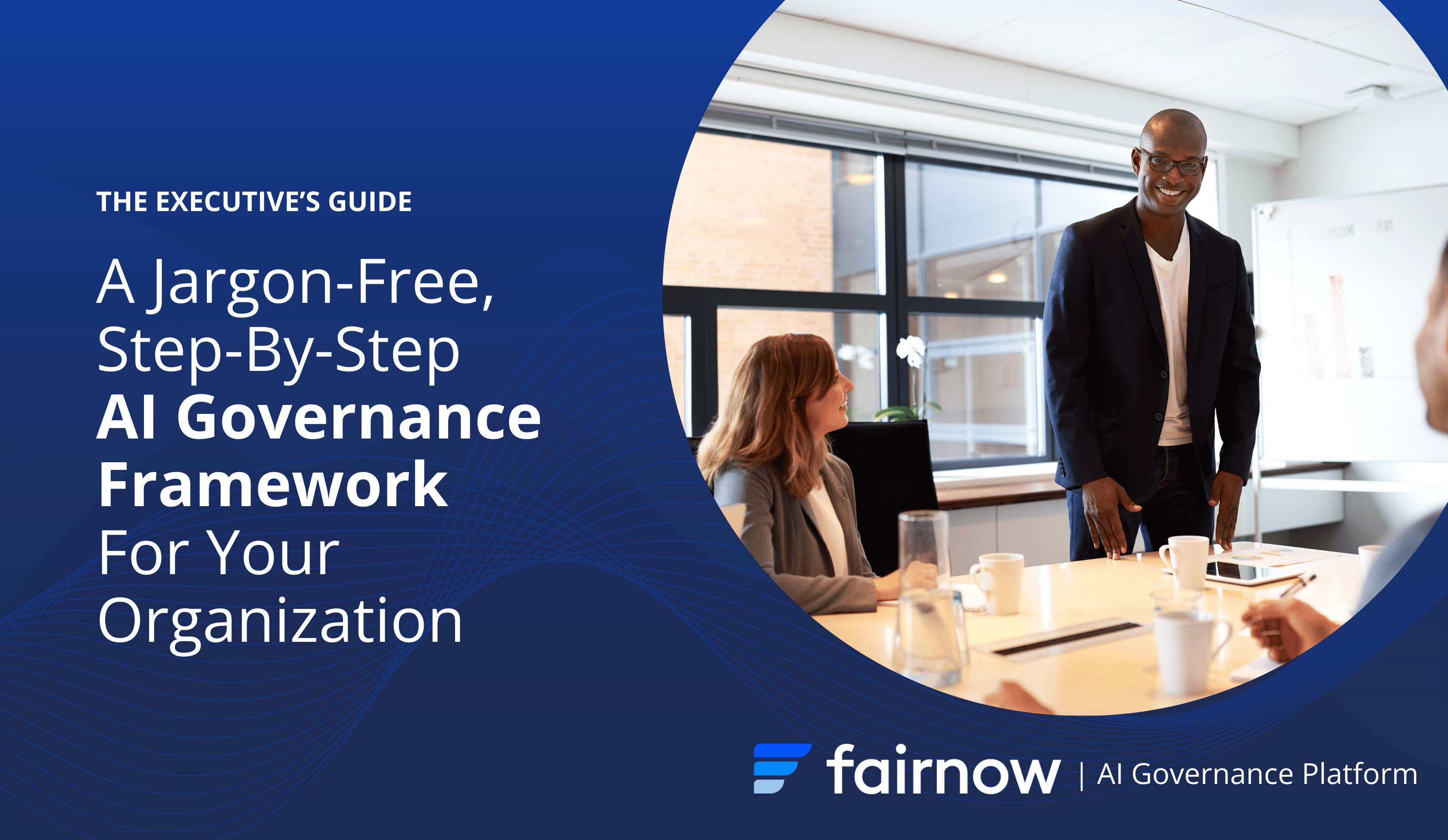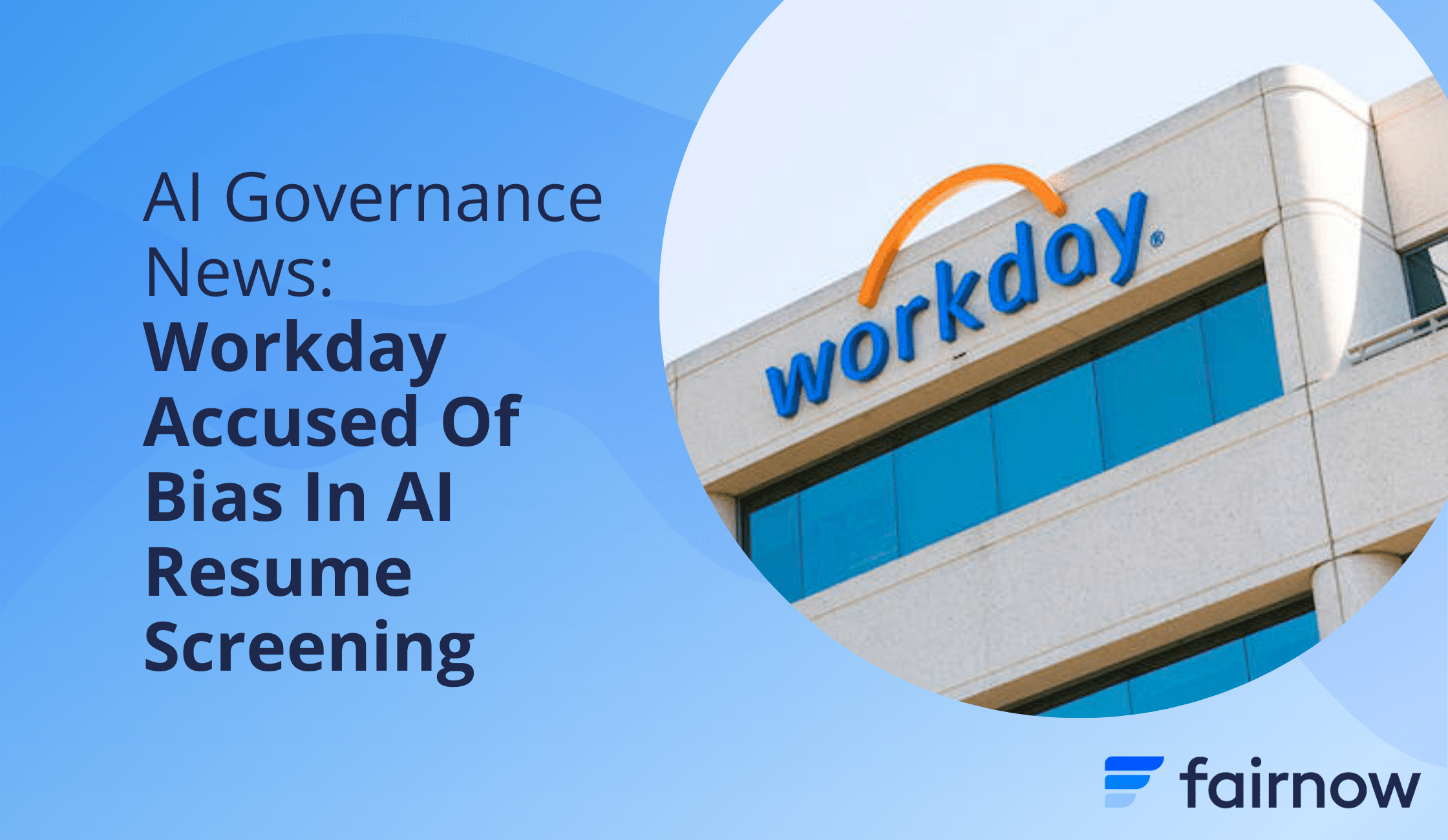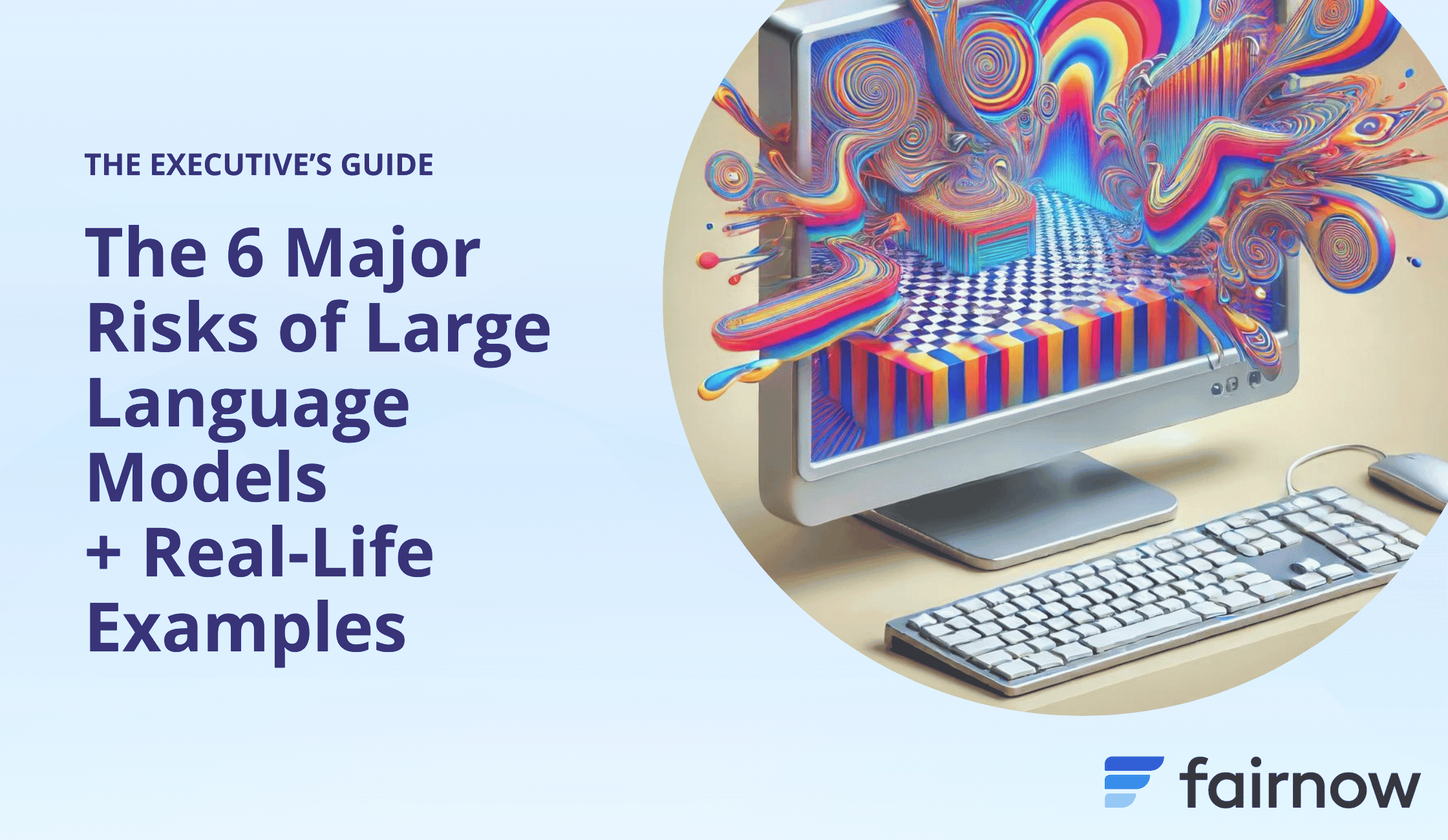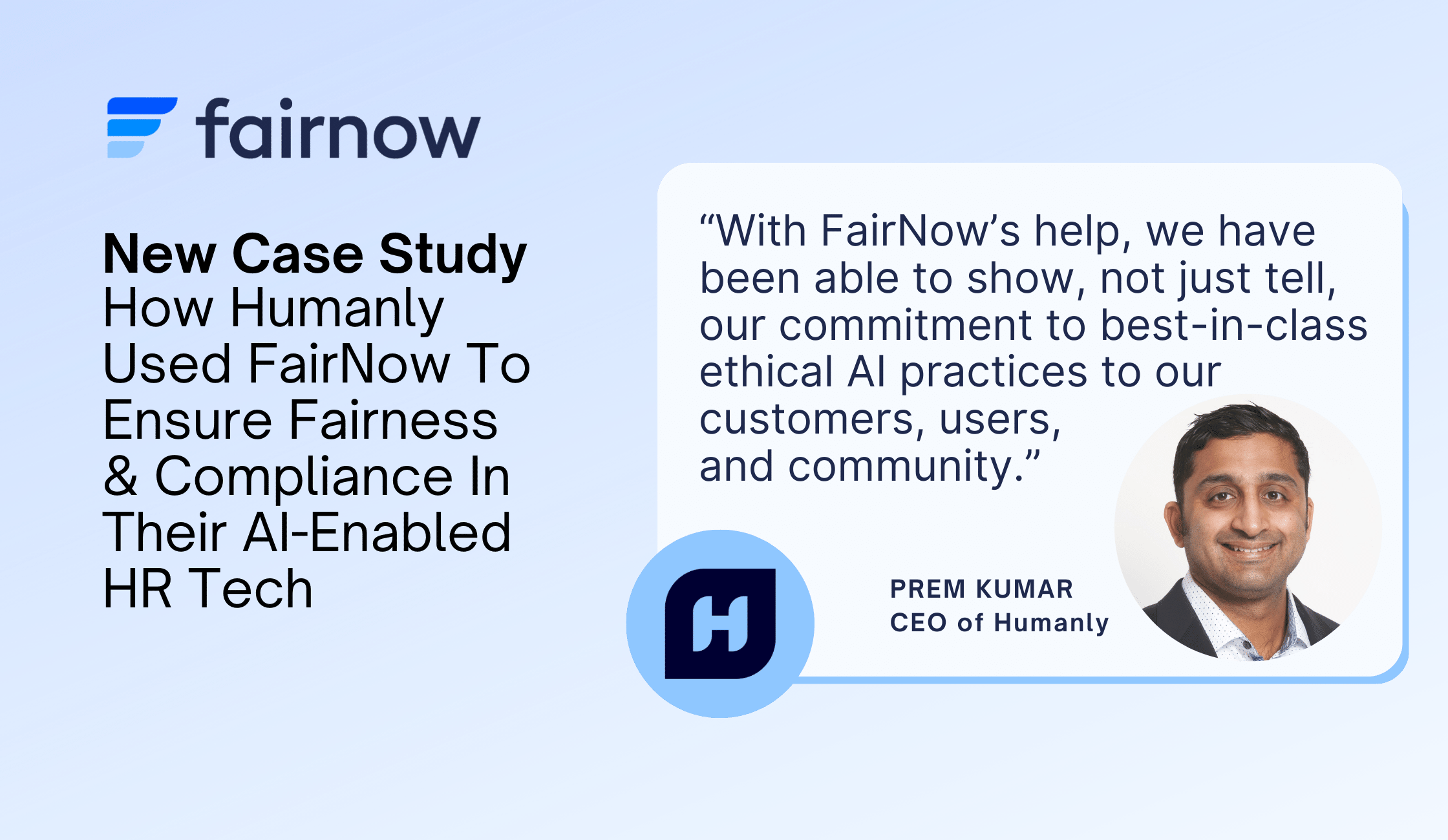What is an AI Governance Framework?
An AI governance framework (or an artificial intelligence governance framework) is the set of guidelines and practices that organizations use to ensure they are managing AI responsibly.
AI governance frameworks lay out the key components of AI governance, and describe how an organization will carry them out.
Best practice AI governance frameworks combine context from key AI regulations like the EU AI Act, voluntary market standards such as the NIST AI RMF and ISO 42001, and deep industry expertise from highly regulated sectors. By incorporating the right context, organizations can ensure that they are taking the necessary steps to identify, mitigate, and manage their AI risks.
What are the Components of an AI Governance Framework?
There are eight components of an effective AI governance framework:
-
- Manage an AI Inventory
- Conduct Risk Assessments
- Establish Roles and Accountabilities
- Conduct Model Testing
- Track Laws and Regulations
- Generate Model Documentation
- Manage Vendor Risk
- Train and Educate Your Team
In this blogpost we will walk through all eight components of an AI governance framework, and provide best practice examples for how to ensure that your organization is executing them well.
1. Manage an AI Inventory
Most leaders don’t actually know how many AI applications that their organization currently has deployed.
Without knowing where you have AI, how your AI works, and what your AI is doing, implementing AI governance is an impossible task. That’s why the first step in any AI governance framework should be to build an AI inventory.
Key Steps:
1) Identify All Your AI: Conduct a thorough audit to inventory every AI tool and model in use, including shadow AI systems that may operate without official oversight. Depending on the size of your organization, this will likely require the help of multiple business units to pull together all models.
2) Capture Model Metadata: Once you have a list of every AI application, record the purpose, data usage, performance metrics, and risks associated with each AI system in a centralized repository. This helps ensure you have visibility into exactly how your AI applications work, and what they’re being used for.
What does this repository look like in practice? It depends.
A small organization with only a couple of low-risk AI applications may be able to manage its model details manually in a spreadsheet.
However, once an organization manages any number of high-risk models, a more formal system will be necessary. A centralized platform becomes ideal for mid-sized and enterprise-level organizations to allow for visibility across teams and regions.
How an AI governance platform can help:
1) Centralized Inventory Management: An AI governance platform like FairNow consolidates all AI models into a single platform, giving organizations visibility into every model’s purpose, data usage, and risk profile. This eliminates silos and ensures that no AI system goes untracked.
2) Automated Data Collection: FairNow automates the collection of critical model information, reducing the risk of human error or documentation gaps. This ensures that all relevant details are accurately recorded while saving hours of manual work.
2: Conduct Risk Assessments
Risk level and key risk factors vary from model to model, and depend AI data, design, and usage.
Regulations like the EU AI Act explicitly adopt a “risk-based approach”, which means that required compliance activities will depend on the AI application’s specific risk level.
An AI risk assessment is an evaluation designed to help you understand how your risky your AI application is, and exactly what the most pressing risks are. This ensures that potential issues are identified early and addressed before they escalate while maintaining compliance with regulatory standards.
Key Steps:
1) Conduct Initial Risk Assessments On Each AI Application: Classify AI models by risk levels based on their use cases and prioritize risk assessments accordingly. Risk assessments should cover:
-
-
- Model’s purpose and intended use
- Data used for training and deployment
- Algorithms and technology
- Key dimensions of usage
-
Given the complexity of risk assessments, it’s important to work closely with legal and risk teams to identify potential exposures and flag any regulatory risks (see step 5).
Not sure where to begin? You can request a free consultation where we can help to determine which regulations apply to your AI applications at a high level.
2) Continuously Identify Risks: Deploy automated tools that monitor AI systems in real-time, detecting risks such as bias, performance degradation, or non compliance.
3) Validate AI Applications Before Deployment: Establish structured testing and approval workflows to ensure AI systems meet ethical and regulatory standards prior to the launch of any AI application.
4) Document Risk Mitigation: Maintain comprehensive records of all identified risks and mitigation actions to provide transparency and support audit readiness.
How an AI governance platform can help:
1) Continuous Monitoring & Automated Alerts: An AI governance platform continuously monitors models, automatically flagging real-time risks such as bias and compliance gaps.
2) Thorough Documentation Of Risk Mitigation: FairNow generates and stores detailed records of risk mitigation efforts, ensuring comprehensive compliance documentation for audits.
3: Establish Roles and Accountability
Clear roles and responsibilities are vital for ensuring oversight and accountability across all AI initiatives. While this segment could be a ten-page document in and of itself, we’ll try to keep it high level.
An effective AI governance program clearly identifies the individuals responsible for leadership and governance activities. It ensures they are well-informed, equipped to make decisions, and held accountable for the outcomes.
Key Steps:
1) Define Specific Responsibilities: Assign roles for AI development, approval, monitoring, and remediation, ensuring accountability at each stage of the AI lifecycle.
2) Form a Cross-Functional Governance Team: Include members from leadership, legal, risk management, compliance, data science, and HR to ensure a holistic governance approach.
3) Establish Escalation Protocols: Create processes for addressing issues, such as biases or performance concerns, where specific stakeholders must intervene. Each stakeholder should understand their role in the escalation process.
4) Develop Transparency Policies: Mandate documentation of AI decision-making processes and provide guidelines on how AI outcomes should be communicated.
5) Require Human-in-the-Loop Oversight: For critical AI decisions, especially those that have been identified as high-risk (e.g., hiring or lending), ensure human oversight is part of the workflow. Human-in-the-loop oversight means keeping humans involved in key decisions made by the AI systems.
6) Create Ethical AI Guidelines: Importantly, ethical AI guidelines need to be communicated from the highest level in the organization. It is wise to implement, and put down in words, clear ethical standards regarding fairness, accountability, and bias mitigation. The amount of formal documentation will depend on the organization but having an overall AI Policy, AI Principles Document, and AI Procedures is a good place to start. More on each document’s purpose and structure here.
Establishing clear internal policies ensures that AI systems are transparent, explainable, and accountable to internal and external stakeholders.
How an AI governance platform can help:
1) Configurable Governance Workflows: FairNow allows organizations to set up workflows that define specific roles and responsibilities for AI oversight, from model development to deployment. This ensures accountability and transparency at every stage.
2) Centralized Policy Implementation: FairNow acts as a single source of truth for your AI policies, making it easier to ensure consistent adherence across teams. Policies related to transparency, ethics, and human oversight can be applied uniformly to all AI applications through the platform.
4: Conduct Model Testing
AI models require constant oversight to adhere to legal and ethical standards.
Automated testing for bias and ongoing evaluations helps maintain fairness, minimize compliance risks, and ensure that AI systems remain transparent and accountable.
Key Steps:
1) Implement A Structured Testing Schedule: Teams that prioritize regular testing and monitoring can detect and address anomalies, biases, and performance issues before they intensify. On a smaller scale, testing can be scheduled and performed manually. However, as an organization grows, continuous monitoring and a reliable system to oversee it become increasingly important.
2) Prioritize High-Risk Systems: Using your ongoing risk assessments (Step 3), focus testing on systems where issues would prove the most hazardous and/or damaging.
3) Integrate Testing And Compliance With Regulatory Compliance Frameworks: Once regular testing is established, the next step is to align automated testing and evaluations with your organization’s broader AI governance framework. By integrating testing protocols with established governance standards, such as the NIST’s AI Risk Management Frameworks or ISO standards, organizations can demonstrate compliance with industry best practices. This alignment also showcases accountability and validates that all AI applications undergo rigorous scrutiny that is consistently applied across the organization.
How an AI governance platform can help:
1) Bias and Fairness Testing: FairNow offers a library of bias tests, allowing teams to run unlimited and automated audits for bias and fairness. Continuous testing and monitoring ensure that AI systems, especially those making decisions that impact individuals’ livelihoods (such as Automated Employment Decision Tools), do not create or perpetuate bias. Organizations are alerted instantly to any concerns, allowing them to detect and rectify anomalies or performance issues before they escalate.
5: Track Laws and Regulations
As new laws emerge and standards evolve, organizations need systems that can track and manage compliance across their AI operations.
Managing regulatory compliance manually is becoming increasingly challenging, especially as the volume of AI regulations expands.
Many organizations, particularly those with numerous AI applications, find that traditional methods, such as spreadsheets and manual workflows, are no longer adequate. As a result, many of FairNow’s clients adopt AI governance software to streamline this process.
Key steps:
1) Leverage Intelligent Risk Assessments: Since many existing and emerging AI regulations adopt a risk-based approach, organizations can strategically leverage risk assessments (from step 3) to focus their compliance efforts. Begin by prioritizing regulatory compliance assessments for high-risk applications and use cases to ensure that the most critical areas receive attention first.
2) Conduct Routine Regulatory Compliance Tracking: Organizations must conduct regular regulatory canvassing to understand the legal environment impacting AI deployments. This involves identifying relevant laws (such as the EU AI Act, NYC LL144, and Colorado SB 205) and standards and mapping out how they affect AI design, functionality, and operations. AI governance committees may need to consult heavily with legal counsel when it comes to regulatory compliance.
3) Perform Regular Compliance Reviews: Given the dynamic nature of AI laws, periodic reviews are essential to ensure ongoing compliance. Schedule regular audits of your AI systems to check for alignment with updated laws and make necessary adjustments to mitigate risks.
How an AI governance platform can help:
1) Automated Regulatory Updates: FairNow continuously tracks and updates its regulatory controls to reflect new laws and standards, providing real-time alerts that keep organizations informed of emerging compliance requirements.
2) Comprehensive Compliance Frameworks: Organizations leverage FairNow’s robust library of regulatory frameworks and controls to ensure alignment with AI laws and standards, reducing the duplication of effort when managing global regulations.
3) Streamlined Evidence Collection: The platform automates the collection of compliance documentation and audit artifacts, ensuring organizations are always prepared for audits and regulatory reviews while maintaining ongoing compliance.
6. Generate Model Documentation
Continuous monitoring and meticulous documentation are key to maintaining governance over the lifespan of AI applications.
Although documentation isn’t everyone’s favorite task, it is absolutely critical for minimizing risk, maintaining accountability, and ensuring that applications meet both organizational and regulatory standards.
Key Steps:
1) Implement Continuous Monitoring Where Possible: Instead of a single annual report, it is a best practice (and, in some cases, a regulatory requirement) to consistently monitor AI applications. Use tools to track the performance and fairness of AI models over time, ensuring that they do not degrade or introduce biases.
2) Maintain Detailed Model Documentation: Regularly update documentation with changes in model parameters, test results, and compliance reports for audit and regulatory purposes.
How an AI governance platform can help:
1) Automated Monitoring: FairNow continuously tracks AI application performance, bias, and compliance, offering real-time insights into potential issues. This automation minimizes the reliance on individual team members or the legal department to identify potential risks, particularly as AI governance becomes increasingly complex.
2) Centralized Documentation Repository: All technical documentation, test results, and monitoring reports are stored in one place, making it easy to retrieve the latest information for audits or regulatory submissions. This eliminates the risk of scattered, incomplete, or inconsistent documentation.
3) Audit Trail Transparency: FairNow provides a clear audit trail for all actions taken on AI models, increasing visibility for compliance officers, internal auditors, and leadership. This comprehensive view minimizes the risk of critical governance gaps.
7: Manage Vendor Risk
Third-party AI systems introduce additional risks, requiring a robust framework for vendor evaluation and oversight.
Every organization that adopts AI will need to identify and manage risks from upstream stakeholders, including companies who develop foundation models like OpenAI, Google, and Anthropic, and companies who create AI solutions that are designed to solve specific challenges.
Managing risks from AI vendors is critical to effective AI governance.
Key Steps:
1) Create Vendor Assessment Checklists: Use standardized questionnaires to evaluate third-party AI systems, focusing on ethical practices, transparency, and compliance. Not sure where to start? We have developed a baseline survey for AI vendors to address vulnerabilities around good governance. Download the 12 Essential Questions To Ask Your AI Vendors Checklist here.
2) Monitor Vendor Performance: Establish ongoing performance monitoring for third-party AI tools to ensure they adhere to your governance standards and continue to deliver fair, unbiased outcomes.
Enforce Contractual Obligations: Include governance and compliance expectations in contracts with AI vendors, specifying regular audits and transparency requirements.
How an AI governance platform can help:
1) Systematic And Standardized Vendor Evaluation: FairNow streamlines vendor risk management by offering standardized assessment tools, ensuring that third-party AI vendors are evaluated consistently and thoroughly. This centralization reduces the chance of oversight or inconsistent evaluations.
2) Ongoing Vendor Monitoring: With FairNow, vendor AI systems are continuously monitored for compliance with internal governance policies and external regulations.
3) Centralized Risk Profiles: The platform allows teams to maintain a centralized risk profile for each vendor, providing organization-wide visibility into potential risks and ensuring that vendor performance aligns with governance standards.
8: Train and Educate Your Team
Understanding AI can be challenging, and it will only become more complex over time. Training programs are essential to close the knowledge gap and ensure all employees are equipped to participate in AI governance.
Key Steps
1) Develop AI Literacy Programs: Implement educational programs for staff to build their understanding of AI technologies, biases, and ethical considerations.
2) Foster a Culture of AI Ethics: Beyond formal training, organizations must cultivate a culture that prioritizes AI ethics and continuous learning. Encourage continuous learning and discussions about AI ethics, so that teams remain up-to-date on governance best practices.
3) Offer Role-Specific Training: Tailor training for different departments (e.g., HR, legal, data science) and job titles to ensure each team understands their role in AI governance and oversight. For example:
AI Builders and Procurers: Those involved in designing, developing, and procuring AI systems, particularly newer Generative AI models, need specialized training on AI design best practices. This includes understanding data quality, algorithm development, and post-deployment monitoring.
AI Governance and Risk Teams: Teams responsible for overseeing AI governance should be trained to assess the systemic risks of individual AI systems. They must be familiar with global regulations and standards and understand how to ensure enterprise-wide compliance to mitigate litigation risks and other challenges.
AI Users: They should understand how to engage with AI in a way that ensures outputs are high-quality and low-risk.
How an AI governance platform can help:
1) Centralized Policies And Guidelines: AI governance platforms centralize AI policies, making them a training and reference tool for all employees. This ensures consistent understanding, easy access to guidance, and up-to-date compliance, reducing governance gaps and promoting consistent, responsible AI use.
9 (Optional): Invest in an AI Governance Platform
We are often asked if you can implement an AI governance program without an AI governance platform. And the answer is: technically, yes.
Not all organizations will require an AI governance platform at this time. For example, a small team using low-risk AI internally can likely manage the tracking and updating of their AI applications manually and may not fall under any compliance requirements.
However, as organizations scale and AI applications increase in complexity and regulatory scrutiny, a governance platform becomes essential.
A survey conducted in partnership by The IAPP and EY, The IAPP-EY Professionalizing Organizational AI Governance Report, found that 60% of organizations with USD1 billion in annual revenue reported having developed or planned to develop AI governance functions within 12 months after the survey (conducted in May, 2023).
A governance platform can centralize and streamline the complex task of AI oversight, ensuring compliance and consistency at scale.
Key Steps:
1) Select A Centralized Platform: Invest in an AI governance tool that allows for seamless tracking of AI models, risks, and compliance documentation across the organization.
Automate Governance Processes: Utilize an AI governance platform to automate bias testing, compliance checks, and vendor assessments to reduce manual overhead.
2) Scale Governance Efforts: As your AI portfolio grows, ensure your AI governance platform is scalable. An effective AI governance platform will track performance, manage risks, and ensure regulatory compliance across all AI systems.
How an AI governance platform can help:
1) Single Source of Truth: FairNow provides a centralized platform for all AI governance activities, creating a single source of truth that reduces confusion and ensures consistency.
2) Automated Processes: By automating governance tasks—such as bias testing, compliance checks, and documentation—FairNow reduces the risk of human error and frees up resources for strategic decision-making.
3) Scalability: FairNow’s platform is designed to scale with your organization’s AI needs, ensuring that as you integrate more models or increase AI complexity, governance practices remain robust and manageable.
Why An AI Governance Framework Is Important
By creating an AI governance framework that defines the eight components of AI governance, organizations can build a sustainable, scalable framework to manage AI risks, ensure compliance, and foster responsible AI use.
This approach not only safeguards against potential risks but also promotes trust and transparency with stakeholders and clients, setting the foundation for long-term success in the age of AI.
By adopting this framework and leveraging tools like FairNow, AI governance becomes empowering, streamlined, and manageable, eliminating unnecessary complexity, frustration, and redundancy.
Looking to simplify AI governance while ensuring consistency across your organization? Request a free demo.
Keep Learning










